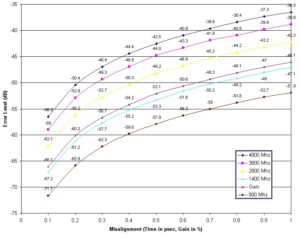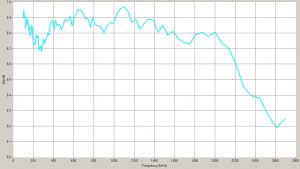D5000 Signal Analyzer – Obsolete
- 10 GSa/s sampling rate
- 5 GHz analog bandwidth (typical)
- All digital parametric measurements
- Eye diagram and jitter analysis
- FFT for frequency-domain analysis
- PRML measurements using Variable Target Viterbi detector
- Media Scanning
- Longitudinal and perpendicular recording methods for parametric and PRML measurements
- Open architecture
- Modular Compact PCI structure with convenient front-panel interconnection
- Integration with RWA2000 series and WITE32 software
The CPCI D5000 Signal Analyzer belongs to a new generation of Guzik signal analyzers. It performs all measurements digitally. The advantages of the digital approach include:
- High accuracy and repeatability of parametric measurements at low SNR. For example, TAA, pulse width, and rise–fall time are measured at less than 1% error at 12 dB SNR.
- PRML algorithms are inherently digital and can be reprogrammed, for example from longitudinal to perpendicular recording.
- Jitter analysis with the ability to suppress and extract different jitter sources, including media noise, read-channel noise, and pattern-dependent jitter. Plots include eye diagram, jitter track, jitter histogram, and jitter spectrum.
The known disadvantage of a digital system, compared to an analog one, is a low processing speed. In order to overcome this problem, the D5000 Signal Analyzer uses a high-speed Digital Data Processor with speeds up to 2.5 Gs/sec (for parametric measurements). The D5000 executes such complicated algorithms as PRML decoding 100 times faster than it is now available for digital oscilloscopes. As a result, the D5000 has a near-real-time throughput. The D5000 modular structure, built on the Compact PCI platform, allows customers to optimize the system for their specific needs.
D5000 Structure
The Guzik D5000 Signal Analyzer incorporates the following blocks and modules:
- ADC10K 10 Gs/sec Data Acquisition Module
- M5000 4 Gbyte Memory Card
- DP5000 high-speed Digital Data Processor

D5000 Chassis
The platform for the D5000 is a standard 6-slot 6U Compact PCI (CPCI) chassis, enhanced with a power supply that generates the standard CPCI power and all extra voltages needed by the cards. The chassis and all Guzik CPCI boards installed inside the chassis are EMI shielded.
D5000 Physical Specifications
- Size (without handle): 17.3” ´ 12.1” ´ 6.2” (43.94cm ´ 30.7cm ´ 15.7cm)
- Weight: 25 lbs (11.3 kg)
Power consumption:
- 110 VAC (± 10%, 50/60 Hz, 2.5A approximately)
- 230 VAC (± 10%, 50/60 Hz, 1.2A approximately)
ADC10K Data Acquisition Module

- One channel with 10 Gs/sec sampling rate (Tektronix ADC)
- 5 GHz analog bandwidth (typical)
- 8 Bit resolution
- Nonlinear distortions < 0.2% at 200 MHz, < 0.5% at 2.4 GHz
- SFDR –50 dBc at 2.44 GHz
- Internal self-calibration
- High speed data interface 80 Gbit/sec to back plane

Figure 1: ADC10K Output Signal Spectrum (FFT) for Input Frequency f = 190.983 MHz and Sampling Clock fc= 10 GHz

Figure 2: ADC10K Output Signal Spectrum (FFT) for Input Frequency f = 2440.983 MHz and Sampling Clock fc= 10 GHz

Figure 3: ADC10K Error Level as a Function of Timing Misalignment for Different Input Frequencies (Sampling Clock fc= 10 GHz)
Alternate ADC8K Data Acquisition Module

- 8 Gs/sec sampling rate
- 10 Bit resolution
- 3 GHz analog bandwidth
- 80 Gbit/sec data transfer interface to memory or data processor
High-resolution module ADC-8000 is built with four interleaved 10-bit ADC from Atmel. The main advantage of the ADC-8000 is the high resolution and, as a result, the high effective number of bits (ENOB) of the device. The main known problem with interleaved ADC is accurate timing and amplitude alignment. The timing misalignment in a fraction of picosecond creates the spur components, which significantly reduce ENOB. The ADC-8000 uses a new equalization Patent pending technology to achieve a high ENOB over entire frequency range of 3 GHz of acquired input signal.

Figure 3: FFT Plot of Acquired Signal, 137 MHz (Left) and 1.6 GHz (Right)

Figure 4: Effective Number of Bits (ENOB) vs. Frequency
M5000 Memory Card

- 80 Gbit/sec interface to back plane
- Up to 4 GByte memory
- Simultaneous write and read modes
DP5000 Digital Data Processor

- Entire spectrum of Parametric and PRML measurements
- Eye diagram and jitter analysis with unique capabilities to separate and measure different jitter components
- FFT for frequency-domain analysis
- Digital Media Scanning with simultaneous detection of different defect types
- Universal Viterbi detector is able to perform Variable Target decoding and work with both longitudinal and perpendicular recording
- Digital filtering, digital equalizing, digital clock recovery
- 40 Gbit/sec interconnection to back plane
- 5 Gs/sec data processing speed (for parametric measurements)
- Parametric measurements based on average pulse profile with 1% measurement accuracy down to 12 dB SNR
D5000 Integration with Guzik Test System

The D5000 Signal Analyzer can be integrated into the Guzik Test System based on RWA-2000 series. This option adds a digital measurement capability to the existing system. The picture below shows the system with RWA-2002, D5000, and V2002 spinstand. The D5000 integrates in WITE32 engineering and production environment.
Host Computer Connection
The D5000 Signal Analyzer connects to the same host computer, which runs WITE32 software controlling the RWA-2000 series read write analyzer and a spinstand. Guzik strongly recommends using the host computer with at least one 1x PCI Express slot to accommodate the PCI Express to Compact PCI bridge used to control D5000. For host computers without PCI Express slots Guzik can provide PCI to Compact PCI bridge. When ordering, please specify the type of the host computer to be used for D5000 Signal Analyzer.


